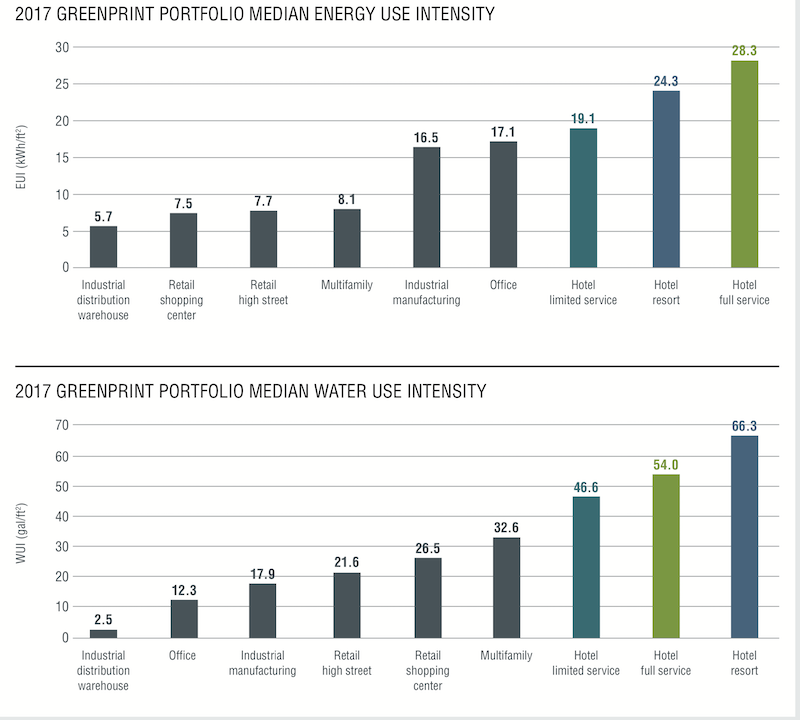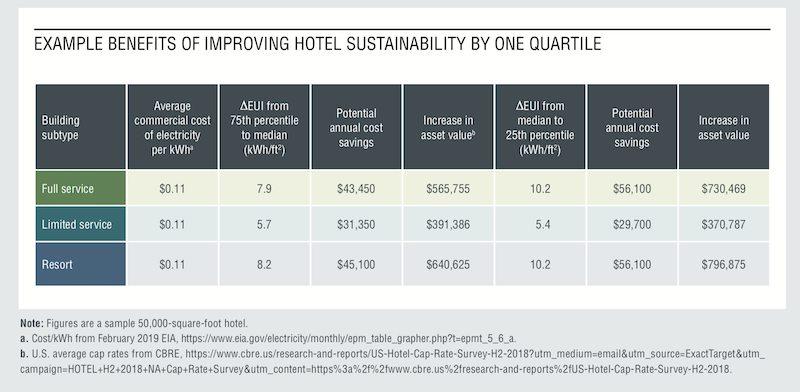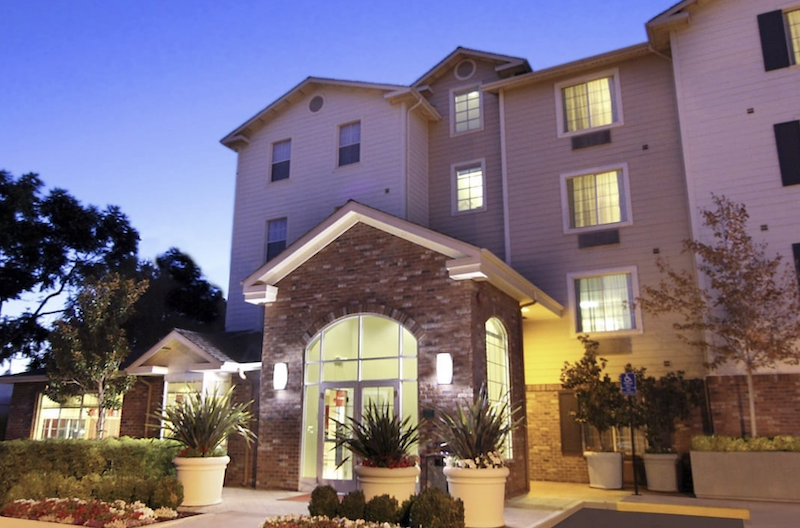A new report about Sustainability in Hotels finds the hospitality industry is still consuming more energy and water than most other commercial and residential sectors. The report, from the Urban Land Institute Greenprint Center for Building Performance, also identifies ways that hotels are becoming more sustainable, and singles out examples of hotels that have taken the necessary steps to reduce their environmental footprint.
The global hotel industry comprises about 184,000 hotels containing almost 17 million rooms, a number that has increased 17.7% from 2008 to 2018.
Of commercial buildings, hotels are among the highest energy and water users per sf (see chart below). The United Nations World Tourism Organization estimates that hotels account for about 1% of global greenhouse gas emissions, a number that is only expected to increase as the industry continues to experience growth and demand. To stay within the 2-degree Celsius threshold for temperature increase agreed upon by the Paris Climate Accord, the hospitality industry would need to reduce emissions 66% by 2030 and 90% by 2050.
The report states that opportunities to improve energy, water, and waste efficiency are widely available for hotels of all types, through operational changes such as utility benchmarking and temperature setpoint adjustments, as well as technical updates like high-efficiency water fixtures or LED lighting installations.
Investments in high-efficiency energy management systems, HVAC retrofits, or on-site renewable energy, require longer project planning and more overall effort. Achieving projects of this magnitude requires collaboration between owners and operators, but can pay long-term dividends for hotels in utility savings and guest comfort.
OPERATING INCOME IS DRIVING SUSTAINABILITY
According to a recent survey of 72,000 Hilton guests, around one third said they prefer hotels with environmental and social programs. Among guests younger than 25, that number jumped to 44%.
Last week, Bee + Hive, a not-for-profit association that unites hotels and partners committed to sustainable tourism, launched a booking platform that will give travelers the ability to plan a vacation based on sustainable experiences.
“Sustainable design is what the market wants,” says W. Edward Walter, ULI’s Global CEO. “Younger and older generations place a high priority on green and sustainable development in how and where they live, work, and play. It’s also what cities need, as they seek to become more resilient, competitive, and livable.”
That being said, the report indicates that the biggest driver of sustainability initiatives in the hotel sector is the potential to improve an asset’s net operating income. “Hotels are a unique asset in that they reap all utility savings from sustainability projects directly to their bottom line, without having to share those savings with tenants.”
In the U.S., hotels in many cities are subject to mandatory utility benchmarking and other building-focused sustainability legislation. New York City’s new building emissions legislation, passed in April 2019, sets carbon dioxide equivalent (CO2e) emissions targets for all building types (for hotels: 9.87 CO2e per sf by 2024 and 5.26 CO2e per sf by 2030).
Many U.S. cities have developed incentives for real estate to “go green” that apply to hotel properties. In Nashville, developments that achieve LEED certification (or another green certification) in the central business district can obtain a density bonus that scales with the stringency of the certification.
Even without sustainability requirements, sustainable features are a strong way to ease community concerns about development, decreasing time spent on approvals and improving project viability. many in the hotel industry have set internal goals for reducing their impact on the environment.

By comparison to other building types, hotels are energy and water hogs, based on the Cornell Hotel Sustainability Benchmarking Index, with which Urban Land Institute has partnered since 2016. Chart: ULI
CASE STUDIES SHOW THE WAY
Hospitality organizations are setting science-based targets for their sustainability goals. In 2019, nine companies, including MGM Resorts International, Hersha Hospitality Trust, and Wyndham Worldwide have committed to setting these targets, and seven—including Hilton, Host Hotels, and Las Vegas Sands—have already had their targets set and approved.
Hilton is committed to cutting emissions 61% by 2030, and Marriott is committed to reduce carbon intensity 30% by 2025.
Hersha, which operates 48 hotels with 7,644 rooms, is cited in the ULI report for its rollout of LED lighting and guest room energy management systems that has saved Hersha’s hotels over $1.5 million annually in utility costs with under 2.5-year payback periods. A more recent rollout of efficiency technology for laundry has reduced Hersha’s water use for laundry by 70-80%. All told, Hersha has reduced its energy use per sf by 15%, its greenhouse gas emissions per sf by 41%, and has diverted 25% of its waste from landfills, saving $11 million since 2010 and creating $65 million additional portfolio value.
Water use in hotels accounts for about 24% of total utility expenses and 15% of total water use in commercial and institutional real estate in the United States. To reduce its intensity, the 23-story 308-room MGM National Harbor Resort & Casino in Maryland, which opened in 2016, installed high-efficiency fixtures that save more than 34 million gallons each year. The hotel’s roof is designed specifically to capture rainwater that is then treated and stored in a 700,000-gallon water cistern. That water is used for irrigation and toilet flushing.
These water efficiency efforts are part of a larger environmentally conscious design strategy at MGM National Harbor, including one of the largest privately operated combined heat and power plants in the Washington, D.C., region.
Sustainability includes environmental stewardship. As part of the high-quality guest experience they want to provide, resorts are protecting their surrounding natural environment and biodiversity. The ULI report points specifically to Terranea Resort, in Rancho Palos Verdes, Calif., which occupies only 25% of its 102-acre site, and conserves 75 acres for natural landscape. Stormwater is channeled through a series of wet ponds and vegetated wetland channels called bioswales for natural irrigation and water treatment, enhancing water quality while serving as a habitat for native avian species.

Savings from sustainable programs can increase the hotel property's value. Chart: ULI
BEST PRACTICES EMPHASIZE DATA SHARING
The ULI report laments, however, that these and other case studies are not more the rule than exceptions to it. It notes that hotels continue to lag in sustainability because owner and operator models create challenges to scale solutions. The lack of data and verification also inhibits future sustainable opportunities. And many hotels still aren’t balancing their sustainability initiatives with their guests’ expectations.
The report offers sustainability best practices for hotels that include:
•Consider sustainability during project design
•Incorporate sustainability into renovations
•Select AEC managers and stakeholders with sustainability expertise
•Collect and analyze energy, water, and waste data to track performance
•Owners and operators should work together to align goals and maintain communication
•Develop the hotel workforce
•Identify partner organizations that can support sustainability programs.
These best practices are likely to be affected, and possibly altered, by trends that are shaping the hospitality sector, such as modular construction, sustainable materials selection, smart-room technology, and a heightened focus on health and wellness.
Related Stories
| Aug 11, 2010
And the world's tallest building is…
At more than 2,600 feet high, the Burj Dubai (right) can still lay claim to the title of world's tallest building—although like all other super-tall buildings, its exact height will have to be recalculated now that the Council on Tall Buildings and Urban Habitat (CTBUH) announced a change to its height criteria.
| Aug 11, 2010
Triangular tower targets travelers
Chicago-based Goettsch Partners is designing a new mixed-use high-rise for the Chinese city of Dalian, located on the Yellow Sea coast. Developed by Hong Kong-based China Resources Land Limited, the tower will have almost 1.1 million sf, which includes a 377-room Grand Hyatt hotel, 84 apartments, three restaurants, banquet space, and a spa and fitness center.
| Aug 11, 2010
Spa resort in harmony with mountain setting
The Sparkling Hill Resort and Wellness Hotel in Vernon, B.C., looks as if it was chiseled out of bedrock and jutting from the mountainside. Designed by the Victoria, B.C., office of Cannon Design, the 240,000-sf resort has 152 guest rooms with floor-to-ceiling windows and spa-like bathrooms, as well as a signature 20,000-sf whole-body wellness spa with treatment rooms designed to feel like they...
| Aug 11, 2010
Expanding retail complex is LEED pre-certified
The Promenade at Coconut Creek in Broward County, Fla., a live-work-play shopping and lifestyle center, is being expanded by 105,000 sf. When phase II of the 335,000-sf project is complete, the facility will house 75 retailers, restaurants, and related services, making it one of the largest mixed-use projects in northern Broward County.
| Aug 11, 2010
CityCenter projects get LEED Gold
MGM Mirage and Infinity World Development have received LEED Gold certification for the first three CityCenter projects: the ARIA Resort hotel tower, ARIA Resort convention center and theater, and the Vdara Hotel (above). The CityCenter developers anticipate Gold or Silver LEED certification for the project's remaining developments, which include a Mandarin Oriental hotel, a 500,000-sf retail a...
| Aug 11, 2010
Philadelphia cancer center seeks LEED certification
The New York office of Thornton Tomasetti provided structural engineering services for the Ruth and Raymond Perelman Center for Advanced Medicine in Philadelphia, a $232 million medical research center and advanced treatment center for cancer and cardiovascular disease. Designed by a joint venture of Perkins Eastman Architects and Rafael Vinõly Architects, the 340,000-sf facility will hous...
| Aug 11, 2010
High-level NICU opens in Washington, D.C.
Design to the highest distinction available by the American Academy of Pediatrics, the new Level IIIC neonatal intensive care unit (NICU) at Children's National Medical Center in Washington D.C., is equipped to care for the sickest premature babies, including those that require open-heart surgery. The 54-bed facility, designed by Karlsberger with KLMK Group as space planner, is four times large...
| Aug 11, 2010
RMJM unveils design details for $1B green development in Turkey
RMJM has unveiled the design for the $1 billion Varyap Meridian development it is master planning in Istanbul, Turkey's Atasehir district, a new residential and business district. Set on a highly visible site that features panoramic views stretching from the Bosporus Strait in the west to the Sea of Marmara to the south, the 372,000-square-meter development includes a 60-story tower, 1,500 resi...
| Aug 11, 2010
San Bernardino health center doubles in size
Temecula, Calif.-based EDGE was awarded the contract for California State University San Bernardino's health center renovation and expansion. The two-phase, $4 million project was designed by RSK Associates, San Francisco, and includes an 11,000-sf, tilt-up concrete expansion—which doubles the size of the facility—and site and infrastructure work.
| Aug 11, 2010
'Feebate' program to reward green buildings in Portland, Ore.
Officials in Portland, Ore., have proposed a green building incentive program that would be the first of its kind in the U.S. Under the program, new commercial buildings, 20,000 sf or larger, that meet Oregon's state building code would be assessed a fee by the city of up to $3.46/sf. The fee would be waived for buildings that achieve LEED Silver certification from the U.







